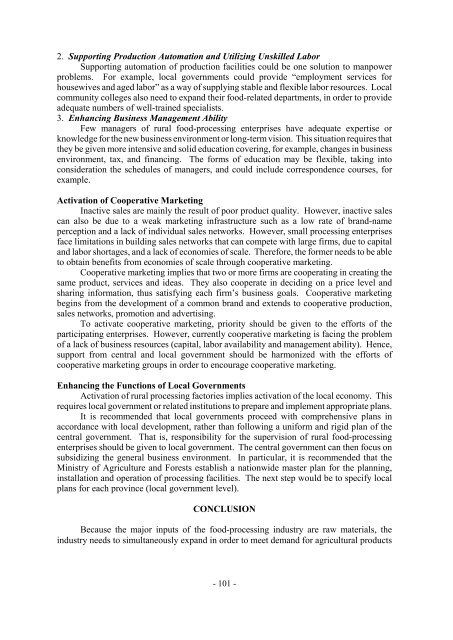Development of Agribusiness Enterprises - Asian Productivity ...
Development of Agribusiness Enterprises - Asian Productivity ...
Development of Agribusiness Enterprises - Asian Productivity ...
You also want an ePaper? Increase the reach of your titles
YUMPU automatically turns print PDFs into web optimized ePapers that Google loves.
2. Supporting Production Automation and Utilizing Unskilled Labor<br />
Supporting automation <strong>of</strong> production facilities could be one solution to manpower<br />
problems. For example, local governments could provide “employment services for<br />
housewives and aged labor” as a way <strong>of</strong> supplying stable and flexible labor resources. Local<br />
community colleges also need to expand their food-related departments, in order to provide<br />
adequate numbers <strong>of</strong> well-trained specialists.<br />
3. Enhancing Business Management Ability<br />
Few managers <strong>of</strong> rural food-processing enterprises have adequate expertise or<br />
knowledge for the new business environment or long-term vision. This situation requires that<br />
they be given more intensive and solid education covering, for example, changes in business<br />
environment, tax, and financing. The forms <strong>of</strong> education may be flexible, taking into<br />
consideration the schedules <strong>of</strong> managers, and could include correspondence courses, for<br />
example.<br />
Activation <strong>of</strong> Cooperative Marketing<br />
Inactive sales are mainly the result <strong>of</strong> poor product quality. However, inactive sales<br />
can also be due to a weak marketing infrastructure such as a low rate <strong>of</strong> brand-name<br />
perception and a lack <strong>of</strong> individual sales networks. However, small processing enterprises<br />
face limitations in building sales networks that can compete with large firms, due to capital<br />
and labor shortages, and a lack <strong>of</strong> economies <strong>of</strong> scale. Therefore, the former needs to be able<br />
to obtain benefits from economies <strong>of</strong> scale through cooperative marketing.<br />
Cooperative marketing implies that two or more firms are cooperating in creating the<br />
same product, services and ideas. They also cooperate in deciding on a price level and<br />
sharing information, thus satisfying each firm’s business goals. Cooperative marketing<br />
begins from the development <strong>of</strong> a common brand and extends to cooperative production,<br />
sales networks, promotion and advertising.<br />
To activate cooperative marketing, priority should be given to the efforts <strong>of</strong> the<br />
participating enterprises. However, currently cooperative marketing is facing the problem<br />
<strong>of</strong> a lack <strong>of</strong> business resources (capital, labor availability and management ability). Hence,<br />
support from central and local government should be harmonized with the efforts <strong>of</strong><br />
cooperative marketing groups in order to encourage cooperative marketing.<br />
Enhancing the Functions <strong>of</strong> Local Governments<br />
Activation <strong>of</strong> rural processing factories implies activation <strong>of</strong> the local economy. This<br />
requires local government or related institutions to prepare and implement appropriate plans.<br />
It is recommended that local governments proceed with comprehensive plans in<br />
accordance with local development, rather than following a uniform and rigid plan <strong>of</strong> the<br />
central government. That is, responsibility for the supervision <strong>of</strong> rural food-processing<br />
enterprises should be given to local government. The central government can then focus on<br />
subsidizing the general business environment. In particular, it is recommended that the<br />
Ministry <strong>of</strong> Agriculture and Forests establish a nationwide master plan for the planning,<br />
installation and operation <strong>of</strong> processing facilities. The next step would be to specify local<br />
plans for each province (local government level).<br />
CONCLUSION<br />
Because the major inputs <strong>of</strong> the food-processing industry are raw materials, the<br />
industry needs to simultaneously expand in order to meet demand for agricultural products<br />
- 101 -
















